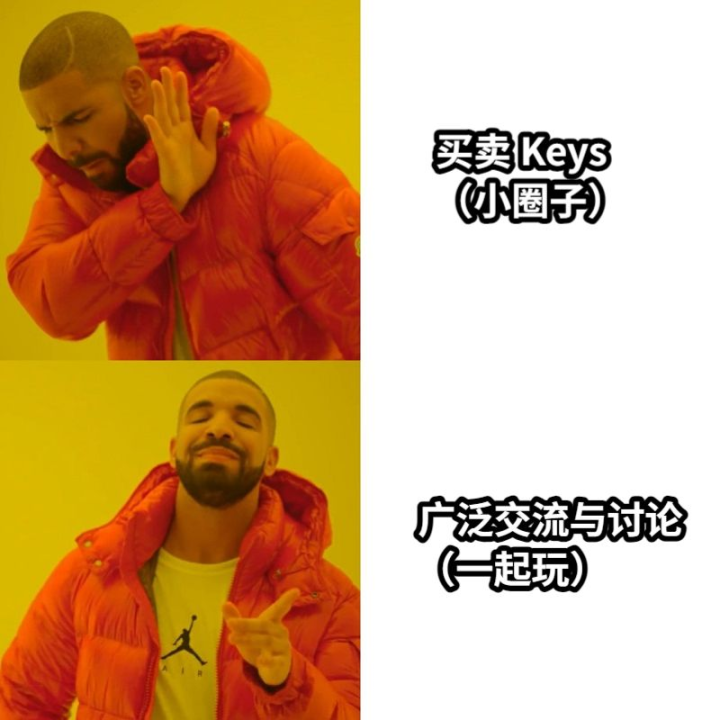Membahas masa depan jejaring sosial kripto: Friend.tech sudah tiada, di mana kita harus berdiri?
Penulis asli: Pzai, Foresight News
Kata pengantar
With Friend.techs daily active users dropping to less than 100, crypto social networking seems to be retreating from the trend. On the one hand, social projects based on the crypto economic model are losing attention; on the other hand, crypto social related applications such as Farcaster and Solana Blinks are using different entry points to make social networking a means of diversion, bringing new growth possibilities to the ecosystem. This article hopes to explore how to build crypto social networking based on the characteristics of each project.
What happened to Friend.tech?
Yes, not many people mention the once-popular Friend.tech now. Some people may still miss the hustle and bustle of the early entry, and some people miss the dopamine when buying and selling keys. Of course, it must be said that FT was a very good product at the time. At least in that relatively bearish stage, the Ponzi-like social structure did provide a place for funds and players to gamble.
If we classify the human social process as the logic of realizing instinct (inner drive), we can roughly divide them into animality and group nature. Animality represents the pursuit of survival resources, while group nature guides humans to enhance individual identity through relationship connection. For Friend.tech, we can see how it uses such instinctive tendencies to establish its economic model.
-
Individual-centered community construction : Consensus is built on the maintenance of individual influence, and the organic migration of influence brings in tokens and attention. The advantage of this model is that it can give early participants the greatest influence monetization and help individuals realize the flywheel of influence. At the same time, similar cognition brings about the aggregation of consensus, generates certain intrinsic value, and solves the pursuit of group.
-
Transactions with Key as the carrier : As a credential for accessing a specific channel, the value of the Key itself is priced through the Bonding Curve, and resources are gathered through the growth of transactions. This gathering is divided into two stages: the early stage (establishing the initial community through early identifiers) and the later stage (using the Key value as its own endorsement).
Obviously, such a construction brings some problems, including the limited growth caused by the ceiling effect and the resistance to building community consensus caused by high speculative participation. As an anonymous former big player said, (Friend.tech) finally became speculation itself. No one wants to chat, they just want to speculate on keys. It seems that when the participants themselves are not coming for simple social needs, all interactions within the protocol are quickly limited to the scope of the token economy, and the closed social model diverts many participants into different small communities, resulting in a relatively dry overall content ecology. The limited discussion space may be the reason that constrains the community derived from Friend.tech and limits wider interactions. In this case, the social narrative is probably unsustainable, and the project party adopted a point incentive mechanism at the time, which also affected the confidence of the holders (for details, please review the discussion on points written by the author).
Through the example of Friend.tech, we can see that there are many pain points in building social networks through cryptoeconomic models, such as the economic model directly determines the sustainability of social interactions within the protocol, and creators are more inclined to economic demands within the protocol. For creators, economic incentives may not be one of the main driving forces of creation. What they need more is extensive interaction and collision of opinions. At this point, the economic model is destined to make the limited reach of creators not meet the expectations of many people. So what we are going to discuss next is how Farcaster, a rising star of the protocol driven by social networking, achieves a certain level of communication and discussion.
(Part of) the creators’ thoughts
What did Farcaster do?
It can be said that Farcaster had almost no connection with the token economy at the beginning of its establishment. The few points of connection may be that the early participants had a strong crypto-native style, such as Ethereum OG and crypto investors. Thanks to the strict invitation-based screening of founder Dan Romero, the quality of early users not only ensured social interaction but also set the tone for the development of the protocol, that is, the new crypto community driven by social interaction. This community is different from general internal groups, and compared with applications such as X, it has a certain sense of community boundaries, which is conducive to the nurturing of community culture. Under the influence of crypto-native, the token economy is slowly entering the social process as an interactive carrier.
A clear example is the success of DEGEN, which was initially launched as a reward token in the Farcaster Degen channel and airdropped to active members of the channel, accomplishing the following three things:
-
Initial community building : Through real social interactions, a group with high interaction rate and strong consensus is established, and then strong growth is generated based on this.
-
Angel round financing : The angel round financing (490.5 ETH) led by 1confirmation in February became a favorable catalyst for the development of the DEGEN-related ecosystem.
-
Building a sense of boundaries : The difference in interaction inside and outside the channel stimulates peoples curiosity and encourages people to discuss more community-oriented topics rather than just individual tweets, thereby building consensus while increasing user participation.
Judging from the daily active growth, DEGEN has become the beginning of everything and even a cultural symbol of the Base ecosystem.
But at this time, people will also find that some resistance is emerging. DEGENs distribution model has undergone changes in mechanisms such as active badges and pledges, and each change is accompanied by the splitting and merging of consensus. And at the end of March this year, Degen Chains Layer 3 narrative was also launched in full swing. At that time, everyone believed that DEGEN was the future of Farcaster and even Base. And the author believes that for a project with MEME as the main narrative point, Buidl means half-heartedness to the market, especially when the construction of consensus has not yet settled. It is true that Buidl itself represents a long-termist concept, but in the ever-changing crypto market, the ecological niche of each project is determined by the current state, and then if there is no real breakthrough in the construction of the ecology, then the climax will no longer continue.
It is certainly right to embrace the ecosystem, and having use cases is also a considerable progress. There are even projects such as Drakula (Note: a Web3 Tiktok supported by Degen) in the ecosystem that provide users with diverse services, but in the end the market enthusiasm began to ebb, and there was no consensus. But the author has always believed that Farcasters innovation has a sufficient lead compared to other social protocols, including Frames, which exists as an interaction paradigm within the protocol, innovating the process of socialized on-chain interaction, opening up the form of third-party clients to allow project parties to co-build, etc. And the most important point is: its social map and framework are open, which is the foundation of everything. So the author believes that in the future, there will definitely be more organic use cases to provide fresh blood for the on-chain social ecosystem.
Blinks – A broad solution
Solana Blinks embeds an interactive interface in the link and conducts transactions through the wallet in the browser. As an application with similar interactive logic to Frames, the two also have many similarities and differences:
-
Mencapai : Solana Blinks’ multi-platform reach allows for a wide user distribution and allows transactions to be made directly through wallets. Frames, on the other hand, interacts through wallet addresses bound to Farcaster and signs through accounts rather than wallets.
-
Openness : Both allow developers to embed corresponding components in the front end and extend the interaction method, and the project parties are providing relevant support to developers.
-
Integration : Ultimately, the goal of this type of interaction is to connect the users on-chain and off-chain experiences.
-
Technical implementation : Solana Actions encapsulates on-chain transactions as APIs and implements general front-end implementation through Blinks; Farcaster Frames transforms static embedding into interactive experience through the OpenGraph standard.
Overall, Blinks does not integrate social itself, but brings a more customized experience to users by embedding on-chain behavior into social streams. In other words, Blinks can be embedded in any stream (for example, Notion), thereby deriving more use cases. In the future, we can also look forward to social stream use cases based on Blinks.
Kesimpulan
Building a social ecosystem that is organically integrated with blockchain has always been a focus of the market, and existing projects can be said to have their own advantages. Just like the tides of the crypto market, the spotlight of attention will not stay forever, so project owners must follow the trend and design products with respect for users and communities in order to carve out a path in the social track.
Let time give the answers that should be given.
This article is sourced from the internet: Discussing the future of crypto social networking: Friend.tech is gone, where should we stand?
Related: Meet Andrew Kang: A Crypto Capital Spokesperson with Assets from 0 to 9 Figures
Original | Odaily Planet Daily ( @OdailyChina ) Author: Wenser ( @wenser 2010 ) Editors note: Recently, Mechanism Capital co-founder Andrew Kang made relevant remarks about bearish ETH. Previously, Azuma, a senior writer of Odaily Planet Daily, also compiled his remarks. For details, please see the article Ethereum Big Short Manifesto: ETH/BTC will fall for another year . Perhaps many people have limited knowledge of him, but he has been deeply involved in the crypto industry for many years. He has invested in high-quality projects with a market value of billions such as Thorchain, Pancakeswap, and Frax Finance, and has also made a lot of gains in trading. Odaily Planet Daily will introduce Andrew Kang in this article in combination with the sharing of X platform user @Atlas for readers…









